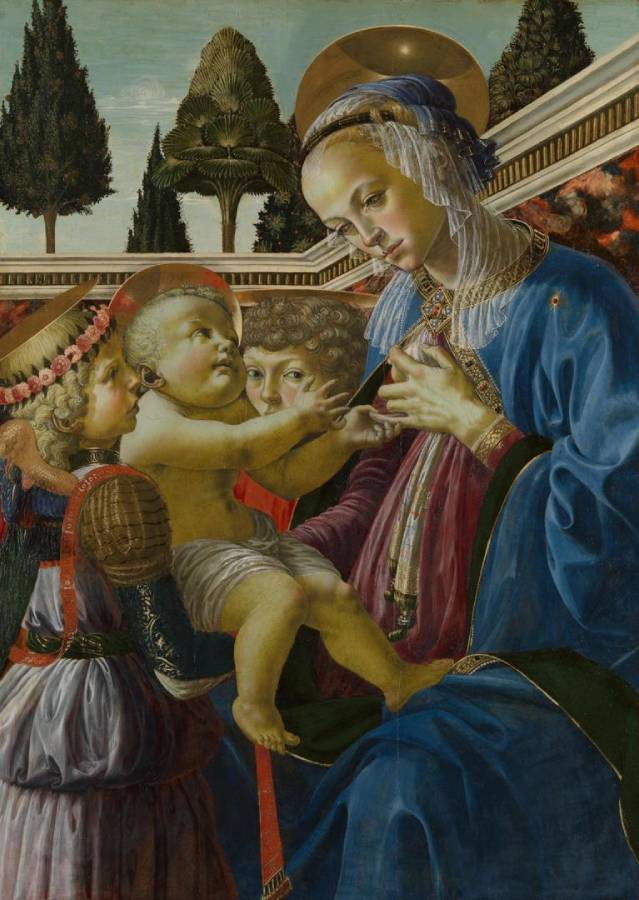Verrocchio, Andrea del (1435-1488)
Madonna col Bambino e due angeli (The Virgin and Child with Two Angels)
c.1467–1469
Tempera on wood, 69.2 × 49.8 cm
National Gallery, London
The focus of this picture is the loving gaze which passes between the Christ Child and his mother, the Virgin Mary. The infant is carried to her by two angels; he reaches urgently towards her as she holds out her breast for him, tenderly grabbing her little finger between his. This familiar baby-like gesture emphasises his humanity, which Christians believe enables God to empathise with humankind.
Although, according to the Bible, Christ was born in humble circumstances – in a stable, to poor parents – he and his mother are shown here in the same magnificent dress as the heavenly angels. The trim of the Virgin’s rich blue cloak is painted with fine brushstrokes to imitate the sheen of the gold thread with which it is embroidered; it is further embellished with precious gems. Her translucent veil is equally luxurious: the density of its rippling folds show how finely woven it is. The abundant lilac robe worn by one of the angels has a satin sheen and his sleeves are woven with gold thread, and the walls of the courtyard are made of colourful marble, represented by splashes of multicoloured paint. The figures are squeezed into the corner of a walled space, probably intended to represent the ‘hortus conclusus’, the enclosed garden, which in medieval spirituality stood for Mary’s virginity – the setting expressing the paradox of the divine mystery of the virgin mother.
The composition is almost identical to one by Botticelli (now in the Museo di Capodimonte, Naples) which itself is probably based on a picture by Fra Filippo Lippi. A picture by an imitator of Lippi in our collection also derives from that composition. The Virgin and Child with Two Angels was long thought to be a derivation of the design by an unidentified Florentine painter but recent technical examination shows that it is likely to have been painted by Verrocchio, the painter who trained Leonardo.
X-radiographs show that the artist altered several details as he painted: for example, the Virgin’s padded headband replaces a plait and the haloes have been repositioned. Evidence of these kinds of changes of mind usually show that the painting was made by the master of a workshop – in this case Verrocchio himself– as opposed to one of his many students, who would often make paintings to his design. The picture also shares similarities with sculptures by Verrocchio, especially one of the Old Testament hero David (Museo del Bargello, Florence). The face of the young hero – particularly the narrow, almond-shaped eyes – is strikingly similar to that of the angel who peers directly at us in the picture. Verrocchio initially trained as a sculptor and a goldsmith before turning his hand to painting. The unusual structure of the palm tree in the centre of the picture seems to be based on a version made in metal – it looks more like an object resembling a palm tree than the real thing. The haloes too look like solid gold dishes rather than weightless discs of light.
The very rich colours, especially the deep blue of the Virgin’s robe, show knowledge of the saturation of colour achievable in the oil painting technique. Verrocchio layered dark blue indigo, more commonly found in north Italian than Florentine painting, beneath the more traditional ultramarine to achieve this depth. The rest of the pigments were commonly used by Florentine artists and all are bound with egg, as was traditional in the city. Elements of the technique, however, are unusual for tempera painting. Infrared reflectography shows that, rather than using fine parallel strokes called hatching to indicate areas of shadow, the artist used broad tonal washes. We know from unfinished paintings by Leonardo that he too used this technique when he was working in oil paint (as in his Saint Jerome in the Vatican Museums). He may well have learned this method from Verrocchio when he was a member of his workshop in Florence. (NG)
